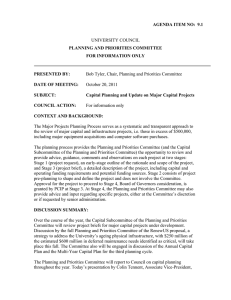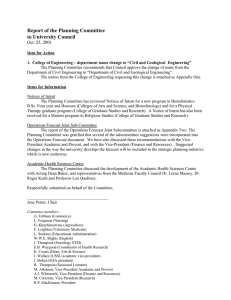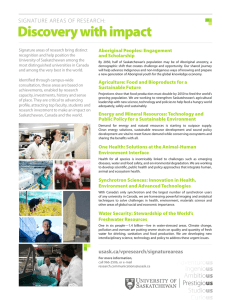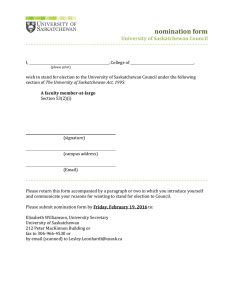Report of the Planning Committee to University Council
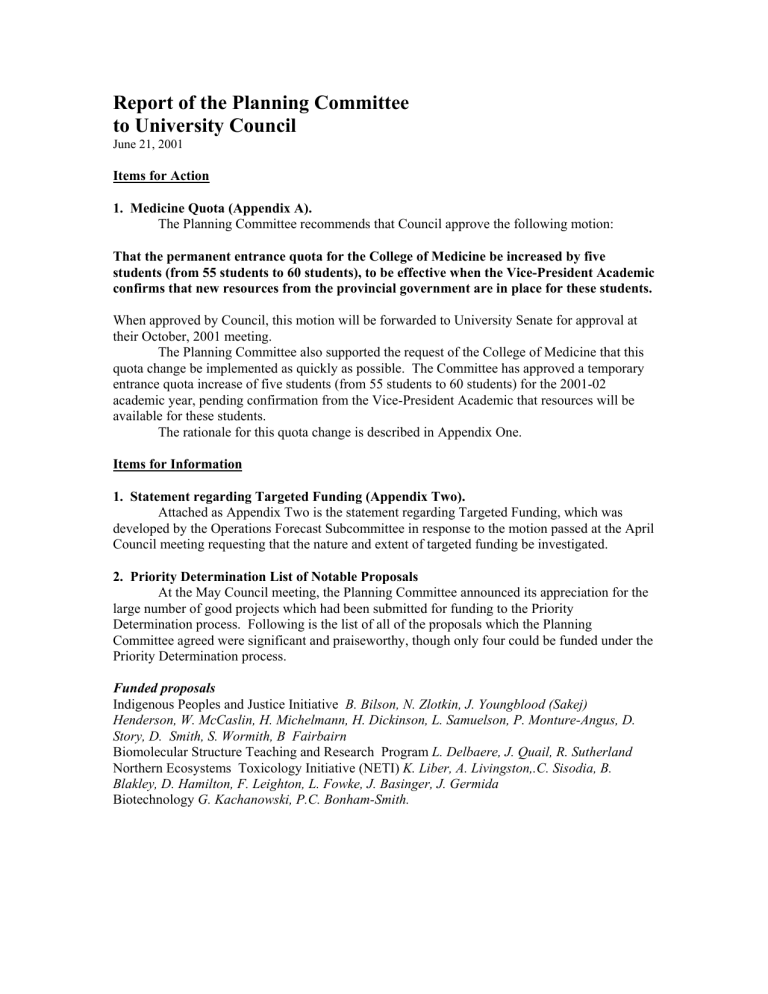
Report of the Planning Committee to University Council
June 21, 2001
Items for Action
1. Medicine Quota (Appendix A).
The Planning Committee recommends that Council approve the following motion:
That the permanent entrance quota for the College of Medicine be increased by five students (from 55 students to 60 students), to be effective when the Vice-President Academic confirms that new resources from the provincial government are in place for these students.
When approved by Council, this motion will be forwarded to University Senate for approval at their October, 2001 meeting.
The Planning Committee also supported the request of the College of Medicine that this quota change be implemented as quickly as possible. The Committee has approved a temporary entrance quota increase of five students (from 55 students to 60 students) for the 2001-02 academic year, pending confirmation from the Vice-President Academic that resources will be available for these students.
The rationale for this quota change is described in Appendix One.
Items for Information
1. Statement regarding Targeted Funding (Appendix Two).
Attached as Appendix Two is the statement regarding Targeted Funding, which was developed by the Operations Forecast Subcommittee in response to the motion passed at the April
Council meeting requesting that the nature and extent of targeted funding be investigated.
2. Priority Determination List of Notable Proposals
At the May Council meeting, the Planning Committee announced its appreciation for the large number of good projects which had been submitted for funding to the Priority
Determination process. Following is the list of all of the proposals which the Planning
Committee agreed were significant and praiseworthy, though only four could be funded under the
Priority Determination process.
Funded proposals
Indigenous Peoples and Justice Initiative B. Bilson, N. Zlotkin, J. Youngblood (Sakej)
Henderson, W. McCaslin, H. Michelmann, H. Dickinson, L. Samuelson, P. Monture-Angus, D.
Story, D. Smith, S. Wormith, B Fairbairn
Biomolecular Structure Teaching and Research Program L. Delbaere, J. Quail, R. Sutherland
Northern Ecosystems Toxicology Initiative (NETI) K. Liber, A. Livingston,.C. Sisodia, B.
Blakley, D. Hamilton, F. Leighton, L. Fowke, J. Basinger, J. Germida
Biotechnology G. Kachanowski, P.C. Bonham-Smith.
Unfunded notable proposals
Proposals for a Cross-College Program in Land Resource Science and for Land Resources Policy
D. Anderson, C. Maule, L. Martz, D. Pennock, R. Redmann, J. Romo, M. Boehm, R. Gray, D.
Buckingham
Computational Biology and Bioinfomatics J. Angel, A. Kusalik
Biogeochemistry Network J. Basinger, R. Kerrich
Physical Activity, Health-related Fitness and Health in Women K. Chad, R. Faulkner, L.
Humbert, K. Spink
Rural and Environmental Health Sciences J. Dosman, A. Backman, E. Barber, M. Crossley, E.
Fernandez, D. Hay, C. Maule, N. Noureldin, R. Olfert, D. Popkin, V. Ramsden, C.
Rangacharyulu, A. Rosenbert, G. Remus, J. Waldram, S. Kirychuk
Natural Health Products: a teaching and research program D. Gorecki, A. Stephen, S. Whiting, B.
Barl, N. Low, G. Scoles, R. Tyler, E. Walker, B. Juurlink, J. McNeill
Trade and the International Regulation of Agriculture R. Gray, D. Buckingham, M. Boehm
Electronic Commerce in a Networked World J. Greer, D. Eager, G. Links
Aboriginal Secondary Teacher Education program V. Hajnal
Centre for Communications Studies J. Rice Henderson, J. Conway, L. Forsyth, L. McMullen, K.
Noels
Saskatchewan Centre for Aboriginal Learning and Research H. Michelmann, E. Walker, J.
Randall, J. Steeves, K. Bell
Reproductive Science and Medicine R.A. Pierson, G.P. Adams, P.F. Flood, R.J. Mapletoft, O.
Olatunbosun, N.C. Rawlings
Centre for Applied Saskatchewan Research D. Smith, J. Randall, M. Altman
Saskatchewan Imaging Research Institute G. Sarty, E. Kendall
Institute of Complex Systems; Institute of Scientific Modeling T. Steele, C. Soteros, J. Merriam,
P. Mezey, R. Miller, J. Pooler, H. Yang
18 th Century Studies program expansion R. Stephanson, G. DesBrisay, P. Hynes, K. James-
Cavan, N. Senior, A. Sokalski, L. Stewart, L. Vargo.
3. Annual Report of the Committee (Appendix Three)
The Annual Report of the Planning Committee is attached as Appendix Three.
Respectfully submitted on behalf of the Committee,
_______________________________________
Jene Porter, Chair
Committee members:
R.P. MacKinnon, President
M. Atkinson, Vice-President Academic and Provost
A.J. Whitworth, Vice-President (Finance and Administration)
M. Corcoran, Vice-President (Research)
J. Wallace (USSU academic vice-president)
J. Bobyn (GSA president)
R. Thompson (Sessional Lecturer)
R.E. Bilson
L. Ferguson
S. Fowler-Kerry
G. Khachatourians
F. Leighton
P. Li
W.W.E. Slights
E.B. Waygood
B.L. Dubray, University Studies Group
P.M. Melis, Office of the Vice-President (Academic)
C. Fornssler, Committee Coordinator, Office of the University Secretary
APPENDIX A
RECOMMENDATION
To: University Council
Date:
Re:
June 21, 2001
College of Medicine – Request for increase of admission quota
Summary of proposal:
The College of Medicine wishes to increase the entrance quota in the College of Medicine by five students (from 55 students to 60 students), effective August, 2001. The increase would be contingent on necessary resources being provided to the college.
Rationale:
This increase is being recommended in response to concerns from the public and from provincial and federal governments that more doctors will be needed to provide health care for Canadians in the future. The Canadian Medical Association and the Association of Canadian Medical Colleges
Task Force on Physician Supply in Canada recommended in November of 1999 that medical school admissions be increased. Increases have already been approved in Alberta, B.C.,
Manitoba and Ontario.
Impact and Relationships:
This increase will not affect any other programs if sufficient additional funding is provided.
Additional resources required:
The College of Medicine has provided an analysis which estimates it will require an increase of about $50,000 annually per student. This is based on a review by a subcommittee of Medicine’s
Budget and Planning Committee led by Associate Dean Robert Card. The Budget Committee is reviewing these figures.
Committee Comments and Recommendation
Academic Programs Committee:
The terms of reference of the Academic Programs Committee require it to consider the academic implications of quotas. When the Committee considered the request from the College of
Medicine to admit 60 students, rather than 55, it noted that no academic rationale for the change had been presented. The view of the Committee is that the reduction of five students several years ago appears to have been based on a perceived need to restrict entry into the profession to control expenditures on health care, while the current expansion of five is based on a request to address a perceived shortage of doctors. In neither case does it appear that academic considerations played a fundamental role in the deliberations. Given the difficulties the College of Medicine has experienced in the past five years, the Committee accepts the proposition that the expansion of the quota should not occur unless new funds are forthcoming. The Committee agreed that students would be adversely affected if the quota were increased without a budget increase for the College and the university. The Academic Programs Committee approved the following motion: That the increase in the quota from 55 to 60 students in Medicine be contingent on resources of $50,000 per student per year being provided to the operating budget from new external resources. (May 2, 2001)
Budget Committee:
The Budget Committee has formed a Subcommittee to investigate the cost estimates as provided by the College of Medicine. The Subcommittee’s report was discussed at the Committee’s June
12 meeting. Committee members expressed concern that the proposal lacked enough detail to ensure that sufficient funds are being requested by the university from the provincial government for the additional students. The Budget Committee will continue to review issues with the
College of Medicine, and will consult with the Vice-President Academic regarding its recommendations.
Planning Committee:
The Planning Committee has approved the following motion: That the permanent entrance quota for the College of Medicine be increased by five students (from 55 students to 60 students), to be effective when the Vice-President Academic confirms that new resources from the provincial government are in place for these students. (June 12, 2001) If approved by Council, this motion would be forwarded to University Senate for approval at their October, 2001 meeting.
The Planning Committee also supported the request of the College of Medicine that this quota change be implemented as quickly as possible. The Committee has approved a temporary entrance quota increase of five students (from 55 students to 60 students) for the 2001-02 academic year, pending confirmation from the Vice-President Academic that new resources will be available for these students.
cc: College of Medicine
Additional attachments referred to in the report are available from the Office of the University
Secretary
APPENDIX B
Statement regarding Targeted funding
for the Council meeting of June 21, 2001
Following discussion of the provincial budget, the April 19, 2001 Council meeting approved the following motion:
BECK/KHACHATOURIANS That the Budget Committee and the Planning Committee investigate the nature and extent of the recourse to targeted funding of the university in the operations budget and report back to the May meeting of Council.
These two committees have formed a Joint Subcommittee to review the Operations Forecast submissions. This subcommittee took on the task of reviewing this issue.
Review
Operations Forecasts are submitted annually in the fall to the Department of Post-
Secondary Education and Skills Training. It is common practice for the university to justify its budget requests with descriptions of specific program initiatives and an estimated cost for these initiatives. The Forecast identifies the provincial funds needed for operational costs and new initiatives, and outlines the University’s overall budget planning. The actual amount of the provincial grant is announced in the spring, as part of the provincial budget. The university budget is then prepared for approval by the Board of Governors.
Provincial Budgets: In September 2000 (in the 2001-02 Operations Forecast), the
University requested an increase of 6.25 per cent overall. Included in that amount was funding for scholarship support and for Nursing. We also noted the need for even more scholarship funds and offered to engage in a matching scholarship program. We highlighted the need for additional faculty in information and communication technologies and the need for additional IT facilities.
2001-02 Provincial Budget: In the March, 2001 Budget, the university received a 3.5 per cent base operating increase (about $4.7 million on a base provincial grant of $141 million).
Targeted funds were also provided as follows:
NEPS program -- Additional funding in the amount of $1.367 million was provided to recognize increased numbers of students, and the cost of delivering the Nursing program in
Regina.
Information Technology program enhancements – Additional funding of $625,000 was provided to expand training capacity for IT students. Approximately 250 new seats are to be created once the plan is fully implemented. The U of R received $625,000 and SIAST received
$250,000 under this program, with the understanding that the universities and SIAST are to work together to develop and implement credit recognition and transfer for computer science students.
Scholarships – additional funding of $200,000 will be provided for a matching merit scholarship program. Operating funds, trust and endowment funds can be used as the
University’s matching contribution.
If these targeted funds were available for general operating requirements, the inclusion of those monies would add 1.61 per cent to the provincial grant. The Board of Governors does retain authority over all funds, including the targeted funds from the provincial government, and they will be incorporated into next year’s base budget.
Federal funding through such programs as Canada Research Chairs and the Canadian
Foundation for Innovation also presents significant targeted-funding issues for the university and the province. By choosing not to participate in these programs, the University would greatly diminish its reputation and its role as a major doctoral-medical university. Many of these programs require matching funds from the provincial government, however, and they may also require additional matching funds from external sources. This adds to the burden of faculty in successfully competing for such funds. Until recently, the provincial government has not readily set up the necessary matching funds.
Areas of Concern
The Subcommittee identified several areas of possible concern and discussed these with the Vice-President (Finance and Resources).
1. Autonomy . The Subcommittee considered whether targeted funding from the province undermines university autonomy. When the increased cost of the base budget has not been adequately funded, the academic program of the university is weakened. Consequently, it is only through the mandated targeted funds that innovation can occur, that some areas are sustained, and that other areas are allowed to grow. University autonomy has clearly been lessened.
2. Flexibility . Targeted funds could compromise the funding available for other priorities because they remove the Board’s flexibility to revise its spending priorities in the light of recent events.
3. Integrity of the Saskatchewan Universities Funding Mechanism. In the 2001-02 budget, targeted funding did not reflect the Saskatchewan Universities Funding Mechanism formula.
4. Federal targeted funds.
Targeted funds from the federal government may represent a still larger problem for the University in maintaining its own priorities and sense of direction.
Directed funding obviously affects which parts of the University will grow, and it also dramatically affects public perceptions of what is of value at a university.
Conclusion
The targeted funds provided to the University in the 2001 provincial budget address the areas that the university itself identified as priorities in the Operations Forecast. Though the
Operations Forecast identified these projects as university priorities, the Forecast also assumed that the provincial government would provide sufficient funds for the base budget increases.
In both the Forecast and the provincial budget, greater emphasis should be placed on the fundamental needs of ongoing academic programs and associated costs.
The Subcommittee also agreed that government must be sensitive to the importance of implementing and maintaining the SUFM formula. Not only must the distribution of postsecondary funding within the province reflect the research needs of the University of
Saskatchewan, the provincial grant must allow the University to pursue federally funded research initiatives that require matching funds.
Targeted program-specific funding may be a welcome supplement when an adequate operating grant has been provided. Such funding is problematic to fiscal management when it is not accompanied by a sufficient increase to the base budget. The 2002-03 Operations Forecast should note that the University has appropriate mechanisms in place to assign funds from its general operating grant to priority areas. This process involves difficult choices between competing and worthwhile claims in areas such as aboriginal programming, student services, faculty recruitment and retention, and dramatically increasing utility costs. The university will continue to make responsible funding decisions and will do so in a fully accountable manner.
Operations Forecast Subcommittee
Jene Porter (chair)
Planning Committee: George Khachatourians, Bill Slights, Ted Leighton, Linda Ferguson
Budget Committee: Bob Gander, Doug MacLean, Joan Llewellyn
USSU: Jack Wallace
APPENDIX C
Annual Report of the Planning Committee to University Council
2000-2001
June 21, 2001
The terms of reference give the Planning Committee a broad mandate including responsibility for:
1. Conducting University-wide academic planning activities and reporting them to Council.
2. Recommending to Council on academic priorities for the University.
3. Balancing academic and fiscal concerns in forming its recommendations.
4. Seeking advice from other Council Committees to facilitate academic planning.
5. Integrating and recommending to Council on matters referred to it from other Council
Committees.
6. Recommending to Council on new programs, major revisions to existing programs, deletion of programs and on enrolment quotas.
7. Preparing Council's recommendations on the Operations Forecast to the President in cooperation with the Budget Committee and in consultation with other Committees of Council and reporting to Council.
The workload for the Planning Committee is significant. This academic year, the Committee held 31
Committee meetings, and several Subcommittees held additional meetings. The Committee also sponsored a one-day workshop on planning issues in the fall, and a half-day workshop in December to discuss the student outcomes report.
Planning activities
In 1998 Council approved the basic planning document for our university, A Framework for
Planning at the University of Saskatchewan. This document outlines four goals:
1. Improving the quality of instructional programs
2. Intensifying research efforts.
3. Fostering the teacher-scholar model.
4. Responding to the needs of Aboriginal people.
The Planning Committee has worked over the last three years to implement these goals.
This year, activities included the following:
• Planning Our Future retreat . In November, the Committee hosted a Retreat entitled
Planning Our Future, which focused on the mandate discussions being held by the provincial government with both universities. This lead to the formation of a Strategy Subcommittee which includes representatives from the Board of Governors, Senate, alumni, the Academic
Programs Committee, the Research Committee and the Instructional Development Committee to draft a Council document which defines the University of Saskatchewan mandate and including strategies for implementing this mandate.
• Student Outcomes Report and workshop . A major research study on student outcomes was published in the fall and widely distributed throughout the university community and to provincial media. The Planning Committee hosted a workshop of university statisticians and social science researchers to review the results. Council approved a motion stating,
“Considering the value of the Student Outcomes survey in areas of accountability and program review, the University Studies Group be responsible for completing a Student
Outcomes study every two years, and providing the results to Council.”
• Aboriginal Goal Subcommittee . In A Framework for Planning at the University of
Saskatchewan (March, 1998) the goal of Responding to the Needs of Aboriginal Peoples is described as follows:
“In Saskatchewan, the task of responding to specific, local needs and, simultaneously opening doors to the world, is particularly pressing in the context of aboriginal peoples.
Making available to aboriginal peoples the full resources of the University is one side of that equation; integrating aboriginal knowledge into the curriculum and practices of the
University is the other. At the University of Saskatchewan we must dedicate ourselves to making available to all aboriginal peoples the full range of our programs and we must adopt strategies that will improve their ability to succeed. Above all, the University must appreciate the need for aboriginal peoples to have an effective, meaningful voice in their own educational experience and, in true partnership, to find in the University a place where their culture is both reflected and at work in defining and achieving the institution’s objectives in research, teaching and community service.”
A Subcommittee was established this year to review the progress that has been made toward achieving this goal and determine additional strategies for the Planning Committee and
Council which will assist the university in its efforts. The Office of the Vice-President
Academic has assembled a list of ongoing programs and had drafted a framework for moving forward, which is still under discussion in the university executive. The Subcommittee intends to work toward this goal next year.
• Members of the Planning Committee also participated this year in the Executive
Communications Council and the Enrolment Plan Steering Committee.
Academic Priorities
Several reports and recommendations were made to Council regarding academic priorities this year. These include:
• Research Plan for the Canada Research Chairs . The Canada Research
Chairs program was announced by the federal government last February. To participate, universities were expected to develop a research plan and have this approved by the university planning authority. The plan was developed over the summer by a Subcommittee led by the Vice-President Academic and the Vice-President (Research), and it was brought to Council last fall. Both the summary and the plan are posted on the university’s website http://www.usask.ca/vpacademic/policies/index.html
• Systematic Program Review . One of the purposes of Systematic Program Review is to identify those academic programs at the University of Saskatchewan which require improvement, and to determine what improvements should be made. SPR demonstrates accountability for programs, provides information to assist in decision-making and resource allocations, and identifies outstanding programs. The SPR policy and procedures, which were approved by Council in 1999, require that each program be given a letter grade of A, B, C or
D by the reviewers. The Vice-President Academic and the Dean of Graduate Studies and
Research then evaluate the reviewers’ findings and either agree or disagree with the evaluations. Finally, the Planning Committee determines whether it agrees or disagrees with the evaluations. In 1999-2000, the Systematic Program Review process reviewed 29 programs from five different colleges, including all of the degree programs in the College of
Agriculture, all of the degree programs in the College of Pharmacy and Nutrition, the graduate program in Toxicology, the graduate programs in Educational Psychology and
Education of Exceptional Children, and the Master of Business Administration program. The
Committee concluded that three types of problems were established by these reviews – faculty shortages, requirements for structural changes in programs, and need for other
resources.
The Committee agreed to inform Council that the external reviewers, with only a few exceptions, praised the commitment in time and effort of the faculty and praised the quality of faculty in even the "C" programs. The Committee shares the opinion of the external reviewers that the faculty members in these programs are outstanding in their dedication to students and to program quality.
• Program Termination procedure . At its April meeting, Council approved a procedure for termination of programs. The two most significant aspects of the procedure are, first, that programs are to be considered for termination based only on recommendations from Colleges, from the President, or from outcomes of the Systematic Program Review process (Category C programs whose action plans are not approved, and Category D programs), and second, that the Planning Committee is to receive advice from the Program Termination Subcommittee, as described in the policy, before it makes recommendations about program terminations to
Council.
• Operations Forecast Review, and Saskatchewan Universities Funding Mechanism . The
Committee’s terms of reference specify that the Committee is to review the Operations
Forecast on behalf of Council. The Forecast is a document presented to the provincial government annually which identifies university priorities for expenditure over the next year.
The Saskatchewan Universities Funding Mechanism is a funding program established by the province in response to the DesRosiers study, under which the University of Saskatchewan is supposed to receive additional funds to correct the imbalance of funding between the
University of Saskatchewan and University of Regina. Documents for both reflect the university’s academic priorities, and are reviewed in this light by the Planning Committee. In both reviews this year, the Planning Committee has supported the priority of faculty revitalization and improvement of academic programs.
• Priority Determination . The Priority Determination Process was developed by the Vice-
President Academic and the Planning Committee of Council, and approved by University
Council in 1998. The Planning Committee sees priority determination as one of a set of strategies for renewal at the University. For more detail about the Priority Determination process, please see A Priority Determination Process for the University of Saskatchewan at http://www.usask.ca/university_council/planning/ projects/rpt-1998-01.html This year, the final priority determination project was approved. The Indigenous Peoples and Justice
Initiative will provide for the development of new undergraduate and graduate programs in
Sociology, Native Studies, Political Studies, and Law. The undergraduate programs will make
Saskatchewan a national leader in Indigenous education. The University of Saskatchewan currently offers more courses in this area than any other university with a Native Studies
Department in Canada. The new programs will be designed to create or enhance an understanding of Indigenous knowledge and ways of knowing. The initiative contemplates the development of a research focus which fosters inter-disciplinary and trans-disciplinary research activity in the area of Indigenous peoples and justice. It is anticipated that this research focus will be enhanced by a relationship with an archival and document centre proposed by the Saskatchewan Archives Board. The initiative will be built on current strengths, including the resources of the Native Law Centre and will involve the College of
Law and several departments in the College of Arts and Science.
The Priority Determination Process resulted in the redistribution of
$1,000,000 to five colleges across the campus. One of the goals of the program was to encourage faculty to develop cross-disciplinary programs of teaching and research. A large number of impressive projects were proposed, only a few of which could be funded. The Planning Committee recently followed up with a number of these proposals, to determine whether their
proponents had found alternate sources of funding to undertake some of the programs which had been proposed. The Committee was pleased to find that several proposals had achieved this. The chair of the Planning Committee and the Vice-President Academic have written to these project leaders to thank them for their proposal. Projects such as these can help to raise research and instruction at the University of Saskatchewan to the high level required in these intensely competitive times.
Administrative issues
The Committee also dealt with several issues this year which are primarily administrative, though like most such issues at a university, they also have academic implications.
Included in this area were:
Merger of Classics and History
Medicine quota
Nursing quota and NEPS agreement
Joint Subcommittee on Council Policy for Research Centres and Units
Joint Subcommittee on Briercrest Affiliation
Committee activities in these areas have been reported to Council throughout the year, and several will carry over into the next year. The Committee has also drafted a set of procedures for quota changes which are now being discussed by other committees. The Joint Subcommittee on Council Policy for
Research Centres and Units will begin meeting next week, and the Joint Subcommittee on Briercrest affiliation will be traveling to the Briercrest campus at Caronport, Sask. later in June for a site visit.
Future Reports
The Planning Committee, in conjunction with the Budget Committee, will present a report to
Council explaining the advice given to the President on the Operations Forecast for 2002-03. It will include recommendations regarding the process as well as the format.
The Planning Committee, in conjunction with the Academic Programs Committee, will present a proposal on Quota Procedures.
The Planning Committee will present a report on the academic strategy required to solidify the
University of Saskatchewan as a member of the medical-doctoral category and as the research university for the province. This document will build upon the Framework for Planning.
2001-2002 Planning Committee members
Jene Porter, Chair
R.P. MacKinnon, President
M. Atkinson, Vice-President Academic and Provost
A.J. Whitworth, Vice-President (Finance and Administration)
M. Corcoran, Vice-President (Research)
J. Wallace (USSU academic vice-president)
N. Hipkin (GSA president) (replaced by J. Bobyn in April)
R. Thompson (Sessional Lecturer)
R.E. Bilson
L. Ferguson
S. Fowler-Kerry
D. Harris
R. Hickie (resigned in December)
G. Khachatourians
F. Leighton
P. Li
W.W.E. Slights
E.B. Waygood
B.L. Dubray, University Studies Group
P.M. Melis, Office of the Vice-President (Academic)
C. Fornssler, Committee Coordinator, Office of the University Secretary
